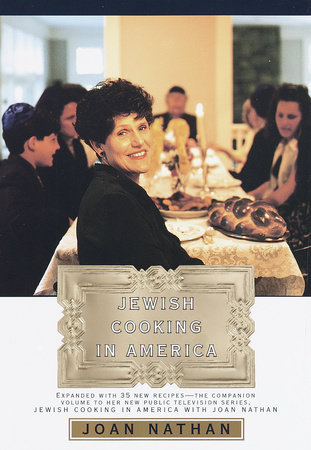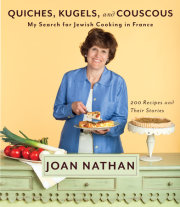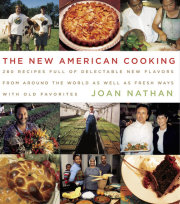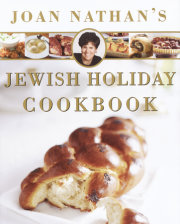Soufganiyot—Israeli Hanukkah Jelly Doughnuts
About 24 doughnuts
Every baker in Israel worth his dough makes thse jelly doughnuts for Hannukkah.
Soufganiya, the modern Israeli word for a doughnut stuffed with jam, also called
ponchik in Russian, comes from the Gree
sufgan ("puffed," "fried," and "spongy") and from the Hebrew
sofiget ("water) and
sofeg ("to blot"). It is typical of new Israeli words that they are sometimes inspired by the Arabic, by the Hebrew, or by other languages, and sometimes just invented; but they are all deeply discussed by the Academy of the Hebrew Language before being incorporated into the lexicon.
In the beginning, a
soufganiya consisted of two rounds of dough sandwiching some jam, but the jam always fell out during the frying. Today, with new injectors on the market, balls of dough can be deep-fried first and then injected with jam before being rolled in sugar. This is a much easier and quicker way of preparing the doughnuts, and no jam escapes during cooking. This recipe is adapted from that of Bulgarian-born Sophi Ashkenazi, one of Tel Aviv's leading caterers. It is perhaps the only distinctly Israeli holiday dish.
1 package dry yeast
3 tablespoons sugar
1/4 cup lukewarm water
3 1/2 cups unbleached all-purpose flour (about)
1/2 cup lukewarm milk
1 large egg
1 large egg yolk
Pinch of salt
Grated zest of 1 lemon
3 1/2 tablespoons butter, at room temperature
Vegetable oil for deep-frying
Apricot jam, about 1/2 cup
Confectioners' or granulated sugar for rolling
1. Dissolve the yeast and 1 tablespoon of the sugar in the water. Let sit for 10 minutes.
2. Put the flour in the bowl of a food processor equipped with a steel blade. Add the dissolved yeast, milk, whole egg, yolk, salt, lemon zest, and the remaining 2 tablespoons sugar. Process until blended. Add the butter and process until the dough becomes sticky yet elastic.
3. Remove the dough to a bowl, cover, and let rise in a warm place for at least an hour. If you want to prepare it ahead, as I often do, place the dough in the refrigerator overnight, then let it warm to room temperature before rolling and cutting.
4. Dust a pastry board with flour. Roll the dough out to a 1/2-inch thickness. Using the top of a glass, cut into rounds about 2 inches in diameter and roll these into balls. Cover and let rise 30 minutes more.
5. Pour 2 inches of oil into a heavy pot and heat to 375 degrees.
6. Drop the doughnuts into the oil, 4 or 5 at a time. Cook about 3 minutes on each side, turning when brown. Drain on paper towels. Using an injector (available at cooking stores), insert a teaspoon of jam into each doughnut. You can also use a turkey baster, first softening the jam in a food processor. Simply push a knife halfway into the doughnut to cut a slit, then put the turkey baster into the slit and squeeze out the jam. Roll the
soufganiyot in confectioners' or granulated sugar and serve immediately.
FLUFFY MATZAH BALLS about 12 large, soft matzah balls
If you like light, airy matzah balls, you'll like this recipe. It's my son David's favorite, especially when his grandmother makes the matzah balls.
4 large eggs
2 tablespoons chicken fat or vegetable oil
1/2 cup seltzer; club soda, or chicken broth
1 cup matzah meal
Salt and freshly ground pepper to taste
1. Mix the eggs well with a fork. Add the chicken fat or oil, soda water, matzah meal, and salt and pepper and mix well. Cover and refrigerate for several hours.
2. Dip your hands in cold water and make about 12 balls slightly smaller than Ping-Pong balls.
3. Bring water to a boil in a large pot. Add salt and place the matzah balls in the water. Cover and simmer about 30 minutes or until soft.
Tip: I often make chicken soup and matzah balls ahead. After cooking the matzah balls I just place them in the warm soup, which I then freseze. The liquid keeps them fluffy. I defrost the soup, reheat, and serve. If you like them more al dente, use large eggs and cook a shorter time.
Note: To reduce the cholesterol in this receipe, use 2 egg whites and 2 whole eggs as well as canola oil.
Copyright © 1998 by Joan Nathan. All rights reserved. No part of this excerpt may be reproduced or reprinted without permission in writing from the publisher.













